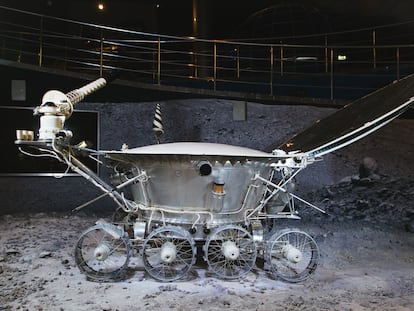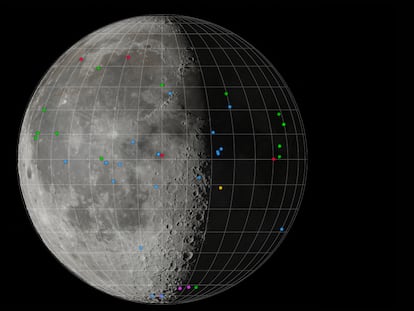Russian space agency says ‘Luna-25’ has crashed into the moon
The spacecraft was scheduled to land on the south pole of the Moon on Monday, racing to beat an Indian probe also heading to Earth’s satellite. The launch was Russia’s first since 1976
Russia’s robot lander the Luna-25 spacecraft crashed into the moon after it had spun into uncontrolled orbit, the country’s space agency Roscosmos reported on Sunday.
“The apparatus moved into an unpredictable orbit and ceased to exist as a result of a collision with the surface of the moon,” read a statement from the agency.
Roscosmos said it lost contact with the spacecraft on Saturday after it ran into trouble while preparing for its pre-landing orbit after reporting an “abnormal situation " that its specialists were analyzing. “During the operation, an abnormal situation occurred on board the automatic station, which did not allow the maneuver to be performed with the specified parameters,” the agency said in a Telegram post.
The spacecraft was scheduled to land on the south pole of the moon on Monday. The lunar south pole is of particular interest to scientists, who believe the permanently shadowed polar craters may contain frozen water in the rocks that future explorers could transform into air and rocket fuel.
The Russian lunar lander was racing to land on Earth’s satellite ahead of an Indian spacecraft, launched on July 14. Both were expected to reach the moon between August 21-23.
Only three governments have managed successful moon landings: the Soviet Union, the United States and China, but not on the moon’s south pole. India and Russia have been racing to be the first countries to land there.
A previous Indian attempt to land at the moon’s south pole in 2019 ended when the lander crashed into the moon’s surface.
Roscosmos said it wanted to show Russia “is a state capable of delivering a payload to the moon,” and “ensure Russia’s guaranteed access to the moon’s surface.”
Sanctions imposed on Russia since it began its actions in Ukraine make it harder for the country to access Western technology, impacting its space program. The Luna-25 was initially meant to carry a small moon rover but that idea was abandoned to reduce the weight of the craft for improved reliability, analysts said.
The Luna-25 launched from the Vostochny Cosmodrome in Russia’s Far East on August 10. The spaceport is a pet project of Russian President Vladimir Putin and key to his efforts to make Russia a space superpower.
The launch earlier this month was Russia’s first since 1976 when it was part of the Soviet Union.
Sign up for our weekly newsletter to get more English-language news coverage from EL PAÍS USA Edition
Tu suscripción se está usando en otro dispositivo
¿Quieres añadir otro usuario a tu suscripción?
Si continúas leyendo en este dispositivo, no se podrá leer en el otro.
FlechaTu suscripción se está usando en otro dispositivo y solo puedes acceder a EL PAÍS desde un dispositivo a la vez.
Si quieres compartir tu cuenta, cambia tu suscripción a la modalidad Premium, así podrás añadir otro usuario. Cada uno accederá con su propia cuenta de email, lo que os permitirá personalizar vuestra experiencia en EL PAÍS.
¿Tienes una suscripción de empresa? Accede aquí para contratar más cuentas.
En el caso de no saber quién está usando tu cuenta, te recomendamos cambiar tu contraseña aquí.
Si decides continuar compartiendo tu cuenta, este mensaje se mostrará en tu dispositivo y en el de la otra persona que está usando tu cuenta de forma indefinida, afectando a tu experiencia de lectura. Puedes consultar aquí los términos y condiciones de la suscripción digital.
More information
Archived In
Últimas noticias
The complicated life of Francesca Albanese: A rising figure in Italy but barred from every bank by Trump’s sanctions
Half of Scotland is in the hands of 420 property owners
Reinhard Genzel, Nobel laureate in physics: ‘One-minute videos will never give you the truth’
Pinochet’s victims grapple with José Antonio Kast’s rise in Chile
Most viewed
- Why we lost the habit of sleeping in two segments and how that changed our sense of time
- Trump’s obsession with putting his name on everything is unprecedented in the United States
- Charles Dubouloz, mountaineering star, retires at 36 with a farewell tour inspired by Walter Bonatti
- The Florida Keys tourist paradise is besieged by immigration agents: ‘We’ve never seen anything like this’
- Living in a motorhome due to soaring housing prices in Madrid: ‘I got used to it quickly, but I don’t idealize it’










































